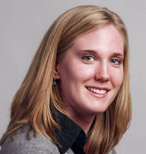By Will Bower
Elizabeth Stangl, a research audiologist in Yu-Hsiang Wu’s Hearing Aid and Aging Research (HAAR) laboratory in the Department of Communication Sciences and Disorders (CSD) in the College of Liberal Arts and Sciences (CLAS), was recently featured in a national article by Associated Press (AP) health writer Devi Shastri. The article covered a new hearing aid feature offered with Apple AirPods Pro 2 and over-the-counter hearing aids in the United States.
The lab has done several studies examining the service delivery model for hearing aids, Stangl said, and focuses on the barriers to hearing aid use and the difference between clinically prescribed hearing aids and over-the-counter models
“Are the over-the-counter devices as good as the professionally fit ones? Maybe, maybe not,” Stangl said. “Just because you pay a lot of money for a device to be professionally fit does not mean that it will be fit well.”

The Hearing Industries Association estimates prescription hearing aids will cost the user between $1,000 and $4,000. Stangl said most insurance plans do not cover prescription hearing aids, which creates a boundary for many people. Over-the-counter models offer a more affordable alternative, with many models available for under $1,000.
Location also plays a major role in one’s likelihood of obtaining hearing aids.
“There are vast areas of the country that don't have an audiologist, so you have to drive a long way to get audiological services,” Stangl said. “Getting those over-the-counter devices into retail stores and online is a way of making them more accessible.”
Stigma can also be a barrier. Stangl said when compared to common sensory aids like glasses, hearing aids are relatively scarce, particularly among young people.
“Most people think if you have a hearing aid, you're old,” Stangl said. “But a lot of younger people have hearing loss.”
The AP article highlighted the new hearing aid feature offered with Apple AirPods Pro 2. Stangl said the feature is not perfect, but she hopes it will help people with hearing loss realize how helpful hearing aids can be.
“I'm hoping it'll be more like what reading glasses were for prescription glasses,” Stangl said. “It just makes the transition to something that you could wear all day a little bit easier.”
Stangl said that while over-the-counter hearing aids are still a work-in-progress, HAAR is optimistic about the future.
“In our view, any amplification is good, as long as it's safe,” Stangl said. “Access to sound can greatly improve quality of life.”